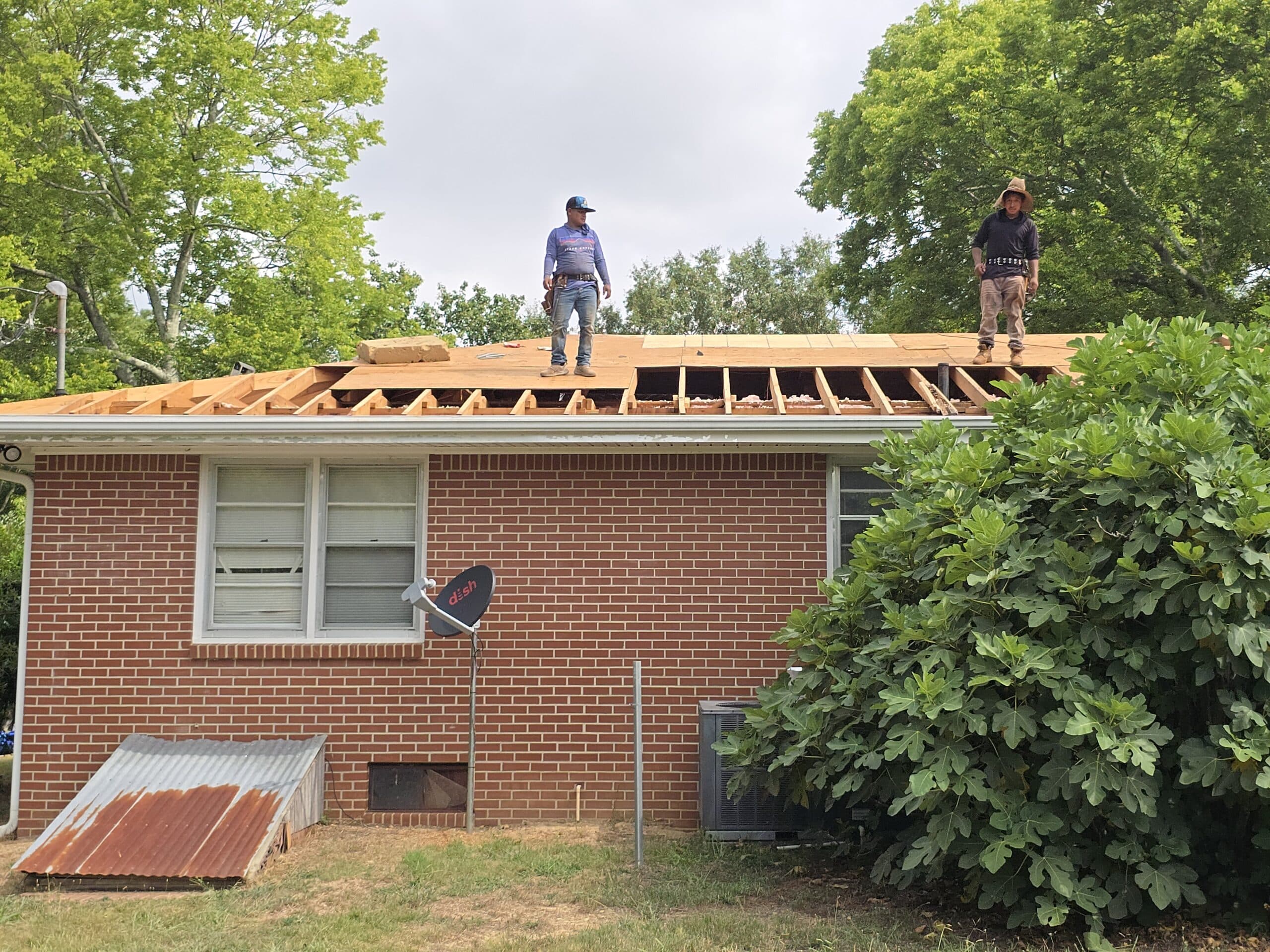
You stand in your yard, staring up at the roof that has sheltered your family for years. It has endured summer heat, sudden downpours, and the occasional storm, but now it is time for replacement. The shingles are only part of the story. Beneath them lies the sheathing, the hidden layer that gives your roof its strength, durability, and long-term protection. Choosing the right material here can mean the difference between a roof that lasts decades and one that leaves you with costly repairs.
For many homeowners, the decision comes down to two materials: OSB, or Oriented Strand Board, and plywood. At first glance, they may look similar, just flat panels of engineered wood, but the differences between them matter. Their strength, cost, and ability to handle Atlanta’s unique climate all play a role in how well your roof will perform.
In this article, we will compare plywood and OSB across the key factors that impact your home, from durability to price, so you can feel confident in the investment you are making. And with Mr. Roofer by your side, you will have the guidance and expertise to choose the sheathing that truly protects what matters most.
OSB vs Plywood: What Is OSB Plywood?
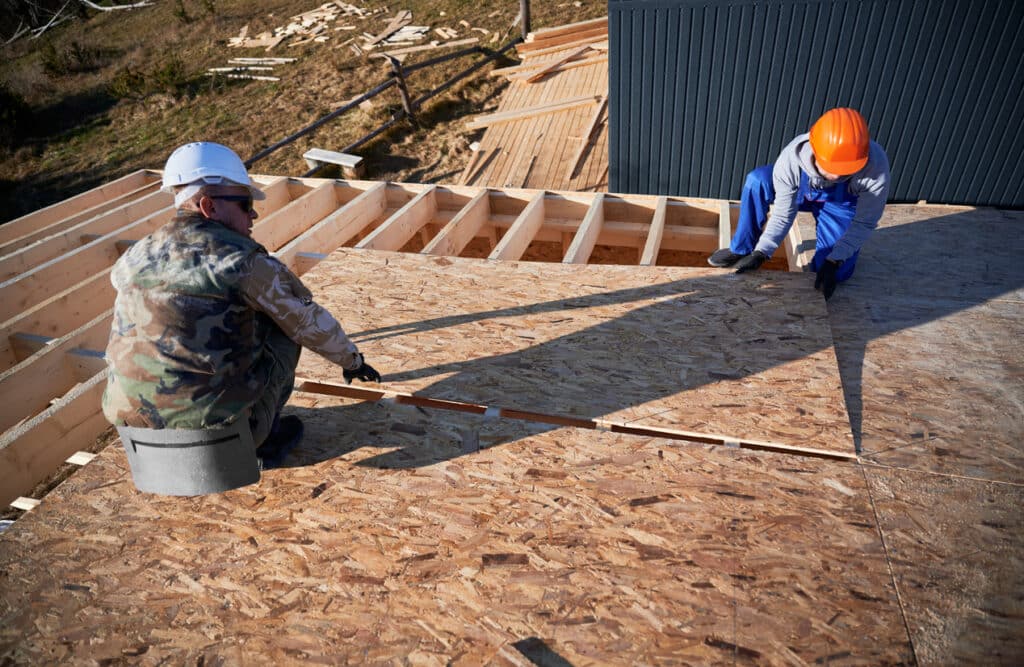
When researching roofing materials, many homeowners come across the terms “OSB plywood” and “plywood”, and wonder if the two are the same product. In reality, oriented strand board (OSB) and plywood are distinct materials, even though they are often grouped together under the general category of structural wood panels used for sheathing. The term “OSB plywood” is a common but inaccurate shorthand that can create confusion.
OSB, short for oriented strand board, is engineered by compressing layers of wood strands or flakes with adhesive resins under heat and pressure. The strands are arranged in alternating directions to improve strength and stiffness, resulting in a dense, uniform panel. Unlike plywood, which is made from thin sheets of veneer glued together in layers, OSB relies on wood chips and flakes to achieve structural integrity. This manufacturing process makes OSB highly resource-efficient since it uses smaller, fast-growing trees and creates less waste compared to traditional plywood production.
To answer the question directly, OSB is not plywood. While both serve similar purposes in construction, their composition and manufacturing techniques are different. Plywood is made from peeled wood veneers, while OSB is made from compressed strands. Both materials fall under the umbrella of wood structural panels, but they should not be considered interchangeable names for the same product.
In practical applications, OSB is widely used for roof decking, wall sheathing, and subflooring. In roofing, OSB panels provide a strong, stable base for underlayment and shingles. Builders often choose OSB for its cost-effectiveness and consistent quality, especially on large projects. It is also commonly used in subflooring, where its structural strength helps distribute loads across joists. However, because OSB is more sensitive to prolonged moisture exposure than plywood, contractors in humid or rainy climates often take extra precautions with installation and ventilation to ensure long-term performance.
OSB vs Plywood: What Is Plywood?
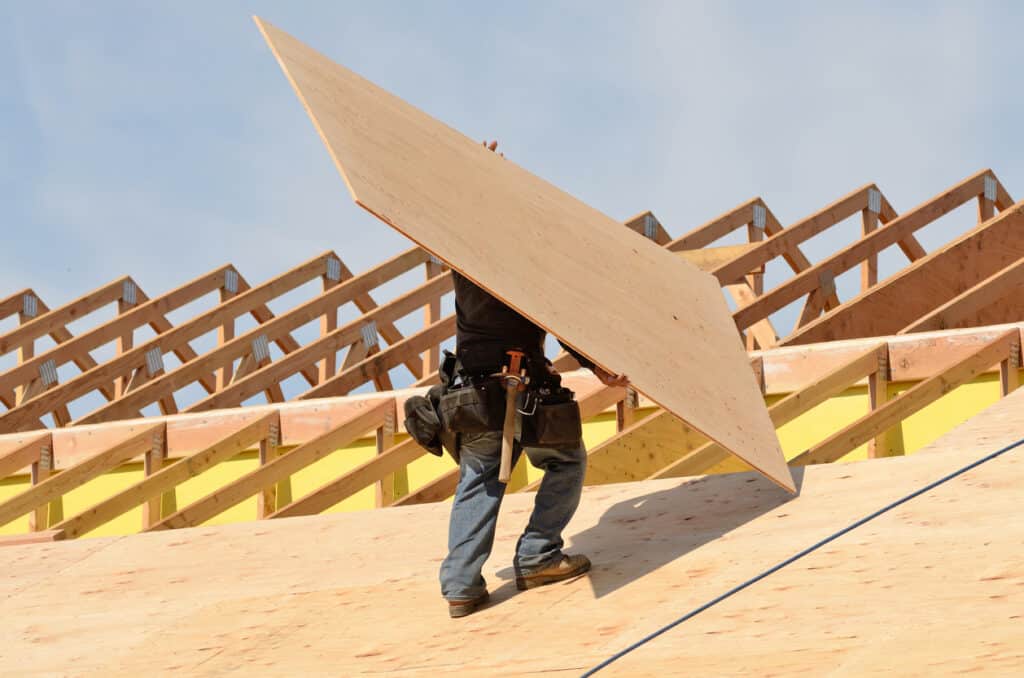
Plywood is one of the oldest and most trusted engineered wood products in construction. It is made by peeling thin layers of wood veneer from logs and bonding them together with strong adhesives. Each layer is laid at a right angle to the one beneath it, creating a cross-grain pattern that greatly enhances strength, stability, and resistance to splitting. This layered construction not only improves structural performance but also reduces expansion and contraction caused by changes in temperature or humidity.
One of the key advantages of plywood is its balance of strength and durability. The cross-laminated veneers provide excellent load-bearing capacity, making it highly reliable for applications where structural integrity is essential. Plywood is also less prone to edge swelling when exposed to short-term moisture compared to oriented strand board, which is why it is often favored in climates with high humidity or heavy rainfall. Premium grades of plywood can also have smoother surfaces, which are advantageous for projects that require both strength and a finished appearance.
In roofing, plywood has traditionally been the standard material for roof sheathing. Sheathing refers to the layer of structural panels attached to the roof trusses or rafters, forming the solid base that supports underlayment and shingles. Plywood’s strength and resistance to delamination made it the default choice for decades, particularly before OSB became widely available. While both plywood and OSB serve as roof sheathing today, many contractors continue to choose plywood when they prioritize moisture resistance, long-term durability, and proven performance in demanding conditions.
The long-standing reputation of plywood comes from its history of reliability. Builders trusted it for generations before engineered alternatives entered the market. Its track record of supporting roofs that withstand decades of weather, storms, and heavy loads has made it a benchmark in roofing construction. Even as OSB has gained popularity for its cost savings and efficiency, plywood maintains its role as a traditional standard, valued for its resilience and consistent quality.
OSB vs Plywood: The Difference Between OSB and Plywood
When choosing between OSB and plywood for roofing, it is important to understand how these materials differ in their construction, physical properties, and long-term performance. While both are classified as structural wood panels, the way they are made and how they respond to real-world conditions can influence which one is the better choice for your project.
Construction Methods: Layers vs Strands
The most fundamental difference lies in how each panel is manufactured. Plywood is made by peeling thin veneers from logs and gluing them together in alternating layers. This cross-laminated construction:
- Creates strength in multiple directions
- Improves dimensional stability
- Makes the panel resistant to splitting or cracking along the grain.
OSB, on the other hand, is manufactured from strands or flakes of wood, which are arranged in layers oriented perpendicular to each other. These strands are bonded with resin under high heat and pressure, forming a dense, uniform panel. OSB’s strand-based composition allows it to use smaller, faster-growing trees, making it more resource-efficient than plywood. However, its layered strands create a different density profile that influences how it reacts to moisture and fasteners.
Appearance, Weight, and Moisture Resistance
Visually, plywood has a smoother surface with visible wood grain from the veneers, which can be appealing in applications where appearance matters. OSB has a distinctive, speckled look due to the compressed wood flakes, which makes it easy to identify.
In terms of weight, OSB panels are typically heavier than plywood of the same thickness, which can make handling more difficult during installation. This difference is more noticeable on large roofing projects where many sheets need to be lifted into place.
Moisture resistance is another key distinction. Plywood generally outperforms OSB when exposed to water, since its veneers resist edge swelling and dry more quickly after getting wet. OSB, while strong and reliable in dry conditions, is more prone to edge swelling if exposed to prolonged moisture. This characteristic means that in climates with high humidity or heavy rainfall, contractors often prefer plywood unless proper ventilation and moisture management are in place.
Difference Between OSB and Plywood in Lifespan and Performance
Both OSB and plywood are designed to meet structural codes and provide dependable performance as roof sheathing, but their long-term characteristics differ. Plywood’s layered veneer construction gives it a slight advantage in lifespan, particularly in environments where moisture exposure is a concern. Its ability to maintain shape and structural integrity over time has been one reason it has remained the traditional standard.
OSB, however, performs very well when installed correctly and kept dry. Its uniformity makes it less likely to have voids or weak spots compared to lower-grade plywood. Many large-scale builders choose OSB because of its:
- Consistent performance
- Availability in larger sheets
- Cost savings
In terms of overall durability, a properly protected OSB roof can last as long as plywood, but it requires stricter attention to installation practices to prevent moisture-related issues.
In summary, plywood tends to have the edge in resilience and proven longevity, while OSB offers cost efficiency and uniformity, making it a smart choice for projects where budget and scale are major considerations.
OSB vs Plywood Strength and Durability
Strength and durability are two of the most important factors when choosing roof sheathing or subflooring. Homeowners often ask whether OSB is stronger than plywood, and the answer depends on how strength is measured and the specific application. While both materials meet structural building codes, they differ in load-bearing capacity, fastener performance, and long-term resilience under varying conditions.
Addressing the Question: Is OSB Stronger Than Plywood?
On paper, OSB and plywood have very similar strength ratings. Both are engineered to meet the same building code standards for structural wood panels, which means either material can be used for roof decking and subflooring without compromising compliance. In laboratory tests, OSB panels often perform just as well as plywood, especially in stiffness and shear strength. This makes OSB a legitimate alternative to plywood in many applications.
However, strength is not only about initial load capacity. Durability under real-world conditions, especially when moisture is present, plays a major role in performance. While OSB is technically strong enough to handle most structural demands, plywood tends to maintain its strength more reliably over time in challenging environments, particularly where humidity and water exposure are factors.
Load-Bearing Ability, Nail-Holding Strength, and Impact Resistance
When it comes to load-bearing, both OSB and plywood are capable of carrying roof and floor loads effectively. OSB panels are dense and uniform, which helps them distribute loads evenly. Plywood, with its layered veneer construction, offers excellent load distribution as well and is slightly more forgiving under extreme pressure, reducing the risk of localized failure.
Nail-holding strength is where plywood generally has the advantage. Because of its solid veneers, fasteners grip more securely and are less likely to loosen over time. OSB holds nails and screws well, but under heavy pull-out forces or repeated stress, fasteners can sometimes lose grip more quickly than in plywood.
Impact resistance is another area where plywood often performs better. The cross-laminated veneers absorb and resist sudden impacts, making it more resistant to dents or punctures. OSB, while strong in static loads, can be more brittle under sharp, concentrated impacts due to its strand-based structure.
OSB vs Plywood Strength in Roofing and Subflooring Applications
In roofing, both OSB and plywood provide sufficient structural integrity to support roof shingles, underlayment, and the weight of workers during installation. However, if the roof is likely to experience prolonged exposure to rain before shingles are installed, plywood offers better protection against swelling and softening, which can compromise nail placement and long-term durability. OSB requires careful handling in these situations, often with protective coverings or quick installation of roofing materials to minimize water exposure.
For subflooring, both materials are widely used, but performance differs under heavy use. OSB is commonly chosen for its affordability and consistency in large projects, especially when paired with tongue-and-groove panels that lock together to prevent movement. Plywood, however, tends to outperform OSB in long-term durability, especially in areas prone to spills, leaks, or high foot traffic. Its superior moisture resistance helps prevent warping and soft spots that can develop in OSB if moisture penetrates the panel edges.
In practice, the choice between OSB and plywood comes down to:
- Balancing cost
- Environmental conditions
- Desired lifespan
OSB can deliver excellent strength at a lower price, while plywood offers a margin of added durability and resilience that many contractors and homeowners view as worth the investment.
OSB vs Plywood Price: Cost Considerations
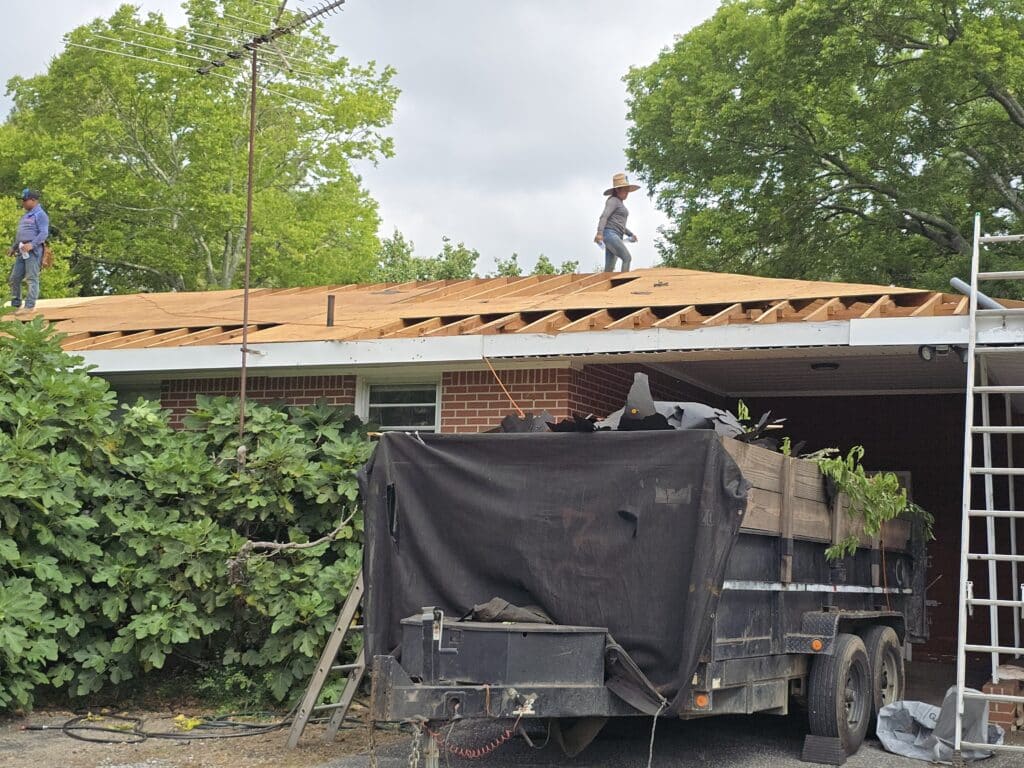
Price is often the deciding factor for many homeowners, contractors, and builders when choosing between OSB and plywood. Both materials serve the same fundamental purpose as roof sheathing, yet their costs can differ significantly depending on availability, regional demand, and long-term performance expectations. Understanding these cost dynamics helps clarify when OSB or plywood is the better financial choice.
Price Differences in Various Markets
In most markets, OSB is consistently less expensive than plywood. On average, OSB panels may cost 20 to 30 percent less per sheet, which can translate into thousands of dollars in savings on large roofing or flooring projects. This price advantage comes from OSB’s more resource-efficient manufacturing process. It uses smaller, fast-growing trees and creates less waste, which reduces raw material costs.
However, prices are not fixed. Market fluctuations, transportation costs, and local supply can sometimes narrow the gap. In regions where plywood is more readily available, the difference may be smaller, while in other areas where demand for OSB is high, the price advantage can be even greater. Seasonal construction booms can also affect pricing, with plywood often commanding higher premiums during peak building periods.
When OSB or Plywood Makes More Sense Depending on Budget
For projects where budget is the primary concern, OSB is often the logical choice. Its lower price allows homeowners and contractors to save thousands of dollars on large-scale builds without sacrificing code compliance or basic performance. This is why OSB has become the go-to option in many tract housing and commercial developments.
On the other hand, plywood may make more sense when the budget allows for an upgrade. While it costs more upfront, plywood offers better resilience to moisture and a longer service life in demanding conditions. Homeowners planning to stay in their homes long term, or those who live in climates with frequent rain and humidity, may find that the extra cost provides peace of mind and avoids future repair expenses.
Long-Term Cost Savings vs Upfront Affordability
The financial decision between OSB and plywood is not just about the purchase price. OSB provides upfront affordability and can deliver excellent performance when installed correctly and kept dry. For builders working on tight margins or projects where speed and uniformity matter most, this cost advantage can be significant.
Plywood, however, may generate long-term savings by reducing the risk of swelling, warping, or premature replacement. A roof deck or subfloor made of plywood is less likely to require repairs due to water damage, which can save on labor and materials in the future. In this sense, plywood’s higher upfront price can be offset by lower maintenance costs and a longer lifespan.
In summary, OSB provides a cost-effective solution for immediate savings, while plywood offers durability that may prove more economical over the lifespan of the roof or structure. The best choice often depends on whether the priority is minimizing upfront expenses or investing in long-term performance.
Here’s a comparison table that summarizes the construction differences, strength and durability, and cost considerations:
Factor | OSB (Oriented Strand Board) | Plywood |
Construction | Made of wood strands arranged in cross-oriented layers and bonded with resin for strength and uniformity | Made of thin wood veneers glued together in alternating grain directions for strength and stability |
Appearance | Speckled, flake-like pattern; smooth, uniform surface; no knots | Wood grain visible; may have knots, patches, or grade variations |
Weight | Heavier, which can make handling more difficult during installation | Lighter and easier to carry, cut, and position |
Moisture Resistance | Susceptible to edge swelling when exposed to water; slower to dry | More resistant to swelling; dries quickly and retains shape after wetting |
Load-Bearing Strength | Comparable to plywood for most structural applications when installed correctly | Slightly stronger in nail-holding power and better impact resistance |
Durability in Roofing | Performs well if protected quickly during installation; sensitive to prolonged moisture exposure | Proven long-term reliability in humid, rainy, and storm-prone climates |
Durability in Subflooring | Commonly used in new builds; may show edge swelling if exposed to moisture | Preferred in high-moisture areas; holds fasteners tightly and resists warping |
Price | 20-30% cheaper per sheet; strong budget advantage for large-scale projects | Higher upfront cost, especially in times of high demand |
Long-Term Value | Lower initial investment but may require more repairs or earlier replacement if exposed to water | Higher upfront investment with fewer repair needs and longer service life |
Best Use Case | Large, budget-sensitive projects where cost savings are critical and moisture exposure is minimal | Premium or custom projects where durability, resilience, and long-term performance matter most |
Plywood vs OSB Subfloor and Roofing Applications
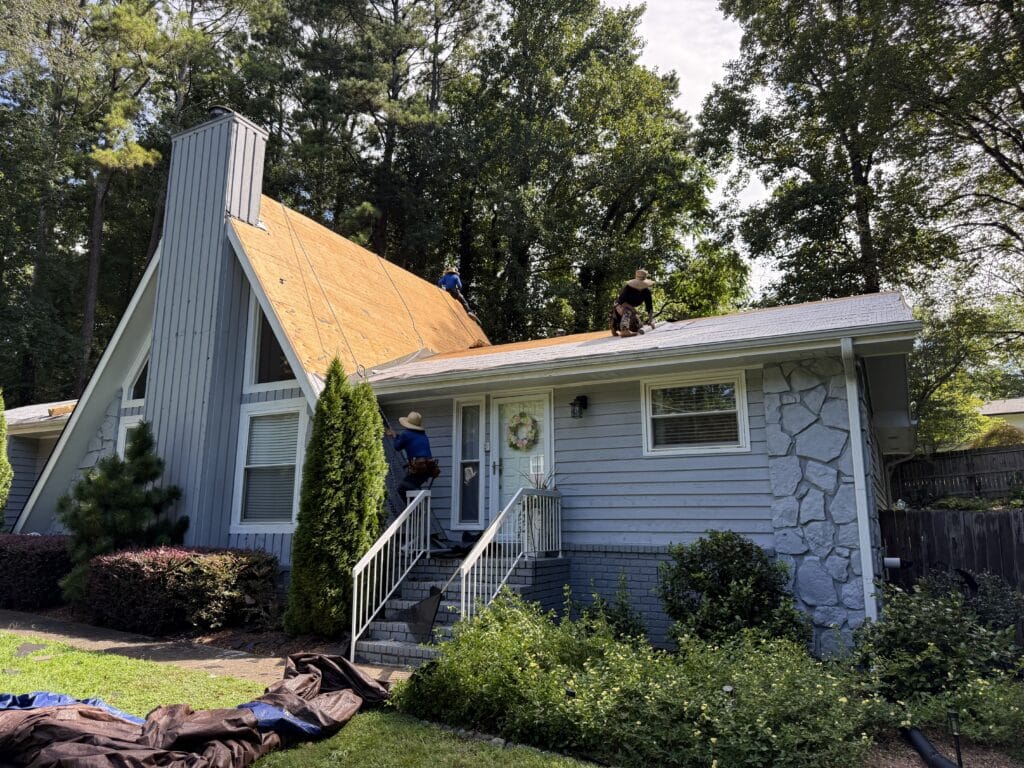
Subflooring and roofing are two of the most common areas where the decision between plywood and OSB carries lasting consequences. Both materials meet structural building codes, but their real-world performance, builder preferences, and even regional regulations can influence which is the better fit for a project.
Pros and Cons of Plywood vs OSB Subfloor
For subflooring, both plywood and OSB are widely used, but they perform differently under everyday conditions. OSB is valued for its affordability and consistent panel size. It works especially well in large-scale builds when paired with tongue-and-groove designs that reduce squeaks and create a more uniform walking surface. However, OSB is more prone to edge swelling when exposed to water from leaks, spills, or construction delays. If moisture is absorbed, the swollen edges can remain raised even after drying, creating uneven spots under flooring.
Plywood tends to be more forgiving in subflooring applications. It resists swelling better and dries faster if exposed to water, making it a safer long-term choice in areas where moisture is more likely, such as:
- Kitchens
- Bathrooms
- Basements
Plywood also offers superior nail- and screw-holding strength, which is an advantage in flooring systems where stability is critical. The trade-off is cost, as plywood panels are usually more expensive than OSB.
Best Uses for Oriented Strand Board vs Plywood in Roofing Sheathing
In roofing, OSB is the most common choice for sheathing in modern construction. Its large, uniform panels provide a stable base for underlayment and shingles, and its lower cost makes it attractive for projects where budget is a primary concern. However, OSB requires careful moisture management. If the roof deck is exposed to rain during construction, the edges can swell, making shingle installation more difficult and reducing long-term durability.
Plywood has long been the traditional standard for roof sheathing. It:
- Holds fasteners more securely
- Resists swelling when exposed to rain
- Maintains structural integrity even in humid climates
This makes it a preferred choice for roofing projects where durability and reliability are more important than upfront savings. Many contractors favor plywood for custom homes, premium builds, and in regions prone to heavy rainfall or frequent storms.
Regional Code Requirements and Builder Preferences
Building codes in the United States allow both OSB and plywood for roof and floor sheathing, provided the panels meet thickness and span ratings specified by local regulations. However, regional climate and builder tradition often determine which material is preferred. In drier areas, such as parts of the Midwest and Southwest, OSB dominates because its moisture sensitivity is less of a concern and its cost savings are significant.
In wetter or coastal climates, plywood is often specified by contractors or even required in certain jurisdictions because of its superior moisture resistance. Builders with decades of experience also influence local preferences. In some regions, long-standing trust in plywood has kept it as the go-to material, while in others, OSB has become the industry standard due to its affordability and efficiency in mass production.
In short, while both materials are code-approved for subflooring and roofing, the final choice is often shaped by:
- Climate
- Budget priorities
- Builder expertise
Pros and Cons: OSB Board vs Plywood for Roofing
When comparing OSB and plywood for roofing, both materials bring clear advantages and disadvantages that affect long-term performance. The decision often comes down to how each handles moisture, how much the homeowner is willing to spend, and the practical challenges of installation.
OSB Board vs Plywood in Terms of Moisture Resistance, Swelling, and Ventilation
Moisture is one of the biggest factors that separates OSB from plywood. Plywood handles short-term water exposure better because its veneer layers resist swelling and dry faster once moisture evaporates. Even if it gets wet during construction, plywood is less likely to stay distorted.
OSB, by contrast, tends to absorb water along its edges more readily. Prolonged exposure can lead to swelling that does not fully subside after drying. This creates raised spots that may affect roof shingle alignment and fastening. In regions with high humidity or frequent storms, this sensitivity can pose challenges unless the roof deck is quickly covered or ventilation is carefully planned.
That said, once installed under proper underlayment and shingles, OSB performs well. Its uniformity and density make it structurally reliable, but it requires better protection during the installation phase and more attention to attic ventilation to minimize long-term moisture risks.
Pros: Cost, Availability, Consistency
OSB’s greatest strength is cost-effectiveness. On average, it costs 20 to 30 percent less per sheet than plywood, a savings that adds up significantly in large roofing projects. This affordability makes OSB the preferred material in much of the residential construction industry.
Availability is another advantage. OSB is widely produced in large sheets, often in sizes bigger than standard plywood, which can reduce seams and speed installation. Its consistency is also a benefit: because OSB is manufactured from wood strands and resins, every sheet is uniform, free from knots or core voids that can appear in lower-grade plywood. This makes OSB predictable to work with, especially on large-scale projects where uniformity matters.
Cons: Water Sensitivity, Drying Time, Weight
The main drawback of OSB is its sensitivity to water. As mentioned, edge swelling can create long-term issues if panels are exposed to rain for extended periods during construction. Unlike plywood, OSB does not dry quickly. Once swollen, it may remain distorted, potentially requiring panel replacement.
Weight is another consideration. OSB is generally heavier than plywood of the same thickness, which can make handling and installation more labor-intensive. This added weight may not be a major issue on small projects, but can slow progress on large roof installations.
In summary, OSB offers cost savings, consistency, and availability, while plywood provides greater moisture resilience and easier handling. Choosing between them often comes down to balancing budget priorities against performance needs in the local climate.
Sheathing vs Plywood: Which to Choose for Your Roof?
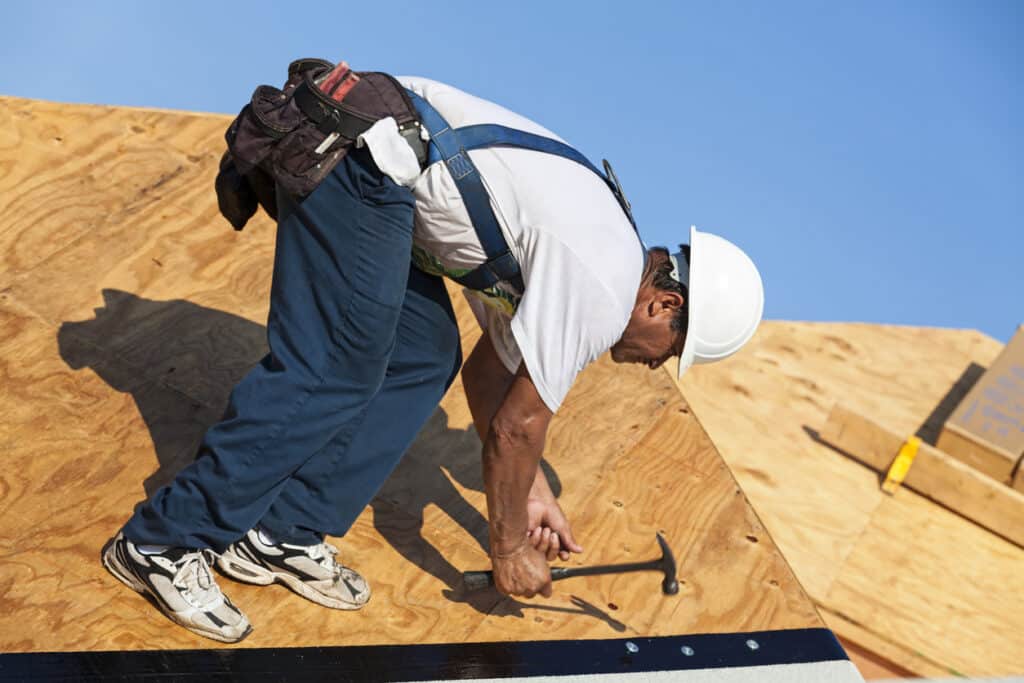
When planning a new roof or replacement, the choice between OSB sheathing and plywood can significantly affect performance, longevity, and cost. Both are approved by building codes and widely used, but each excels under different conditions. Understanding when to use OSB and when plywood may be the better choice helps homeowners make confident, informed decisions.
When to Use OSB as Roof Sheathing
OSB is often the preferred choice for large residential and commercial projects because of its cost-effectiveness and consistent quality. It is manufactured in large, uniform sheets, which reduces seams and speeds up installation. This makes it especially practical for tract housing, multifamily developments, and projects with tight budgets.
Because OSB is strong and meets all structural requirements for roof decking, it performs reliably when properly installed and kept dry. Once covered with underlayment and shingles, it provides a stable base for the roofing system. Builders often choose OSB when budget savings are a priority, and the construction schedule allows the panels to be quickly covered before rain or moisture exposure becomes an issue.
When Plywood May Be the Better Option
Plywood is often chosen for roofing projects where durability and resilience matter more than cost savings. Its ability to resist swelling, recover after moisture exposure, and dry faster makes it more reliable in climates with frequent rain or high humidity. Contractors also prefer plywood when working on custom homes, high-end projects, or in regions where long-term roof performance is the top priority.
In addition, plywood holds nails and screws more securely, which is a key advantage for roofing systems that rely on strong fastener grip to resist wind uplift. This makes plywood a safer long-term investment for areas prone to storms or severe weather events.
Here’s a clear decision guide table you can use at a glance:
Choose OSB Sheathing if… | Choose Plywood Sheathing if… |
You want the most affordable option and need to save on upfront costs | You are willing to invest more upfront for long-term durability |
The project is large-scale (tract housing, multifamily, commercial) where consistency and sheet uniformity matter | The project is custom, high-end, or requires premium materials |
You can ensure quick installation and protection from rain during construction | The roof may be exposed to rain or humidity before shingles are installed |
You are building in a drier region where prolonged moisture exposure is less of a concern | You are building in a humid, coastal, or storm-prone climate where moisture resistance is critical |
Speed and efficiency of installation are top priorities | Nail-holding strength, resilience, and proven performance are higher priorities |
Climate, Installation Speed, and Warranty Considerations
Climate is one of the most important factors in deciding between OSB and plywood. In drier regions, OSB often dominates because its moisture sensitivity is less of a concern. In coastal or humid climates, plywood’s moisture resistance makes it the safer choice.
Installation speed also plays a role. OSB sheets are available in larger sizes and are very uniform, which can reduce labor time on large projects. Plywood, being lighter, is easier to handle and can be quicker to install on smaller or custom jobs.
Finally, warranty considerations should not be overlooked. Some roofing manufacturers and contractors may have specific requirements for the type of sheathing used in order for warranties to remain valid. Homeowners should confirm whether OSB or plywood is specified in warranty documentation before making a final decision.
In summary, OSB provides affordability and efficiency for large-scale builds, while plywood offers durability and peace of mind in demanding climates. The best choice often depends on balancing budget with long-term performance expectations.
Conclusion: Making the Right Choice for Your Roof
When it comes to plywood vs OSB for roofing, both materials offer distinct advantages and drawbacks. OSB is often the more affordable and uniform option, making it attractive for budget-conscious or large-scale projects, while plywood provides stronger moisture resistance, faster drying, and proven long-term durability. There is no single right answer because the best choice depends on factors like your budget, local climate, and specific structural needs.
Before making a final decision, it is essential to consult local building codes and talk to a trusted roofing professional who understands the demands of your region. For homeowners in Atlanta, that means working with experts who know how Georgia’s heat, humidity, and storms can affect your roof over time.
At Mr. Roofer, we take the guesswork out of the process by guiding you toward the sheathing that will best protect your home and deliver lasting value. If you are planning a new roof or replacement, contact Mr. Roofer today to get expert advice and quality craftsmanship you can rely on.
